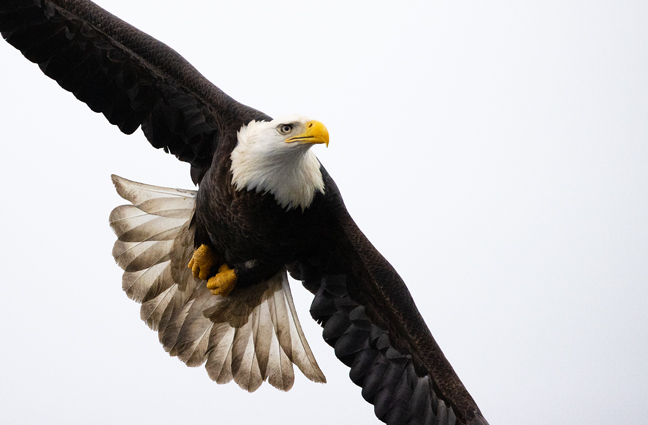

The Odyssey of Homer's Eagles
I recently visited Homer, AK to photograph bald eagles. I had been to Homer in the winter once before to do a story on Jean Keene, the Eagle Lady, who for decades fed bald eagles at the end of the Homer Spit. Hundreds of eagles would gather to feed on fish and carrion that she put out and hundreds of photographers would show up. The City Council banned this practice after her death more than a decade ago and I was interested in seeing how (or if) things had changed.
Homer is a quiet town in the winter months compared to the summer when it overflows with tourists and floatplane passengers. During the winter there are a few commercial fisherman in town preparing for the upcoming season and a few folks fishing for king salmon or crabbing. There are also bald eagle photography tours that regularly depart from the harbor. Since the feeding of bald eagles was banned in Homer, photography guides now use beaches across the Bay and in nearby Peterson and China Poot Bays.
They fill a tub with a box or two of frozen herring, hire a fish thrower and take customers out where they’ll spend a few hours each morning and afternoon photographing bald eagles competing with the glaucous gulls for the small dead fish. It’s easy to make beautiful photographs of eagles in flight, eagles fishing for hand-tossed frozen herring and eagles sitting on drift, posing for portraits. Often, guides don’t advertise that they bait the eagles and photographers only learn of this practice after they arrive. Many don’t care and just welcome the opportunity to make great photographs of bald eagles. Others, like me, do care.
No doubt, it’s a lot more fun and a lot easier to have bald eagles gliding down to the water grabbing frozen bait fish every few minutes than waiting for hours for such a possibility to naturally occur, especially in the winter in Kachemak Bay where there are few fish for eagles to feed on. And, especially when participants have paid for the privilege. I believe that guides offering such workshops have an obligation to be upfront about what they are doing so that photographers can decide beforehand whether or not they wish to participate under such conditions.
The National Audubon Society says, “Though you may be tempted to set out food to draw eagles closer in order to get a great shot, baiting Bald Eagles isn’t just ethically untenable, it’s also arguably illegal, as it could be interpreted as a violation of the Bald and Golden Eagle Protection Act.”
I don’t make a living photographing wildlife and I don’t feel that I should judge other photographers who do. It’s not an easy way to make a living. I like being in wild places and sharing my images with friends who will never come to such places. I could have walked out of the opening meeting, packed my bags and gotten an earlier flight home, but that wouldn’t have accomplished anything. This way, you know how I feel about baiting wildlife for photography, know that all of the fishing shots that I am sharing do not represent natural behaviors and know to question similar photographs that you see.
©Rich Beckman
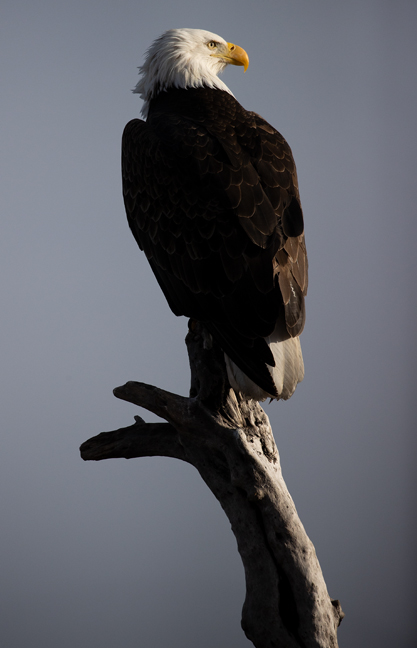

The Odyssey of Homer's Eagles
I recently visited Homer, AK to photograph bald eagles. I had been to Homer in the winter once before to do a story on Jean Keene, the Eagle Lady, who for decades fed bald eagles at the end of the Homer Spit. Hundreds of eagles would gather to feed on fish and carrion that she put out and hundreds of photographers would show up. The City Council banned this practice after her death more than a decade ago and I was interested in seeing how (or if) things had changed.
Homer is a quiet town in the winter months compared to the summer when it overflows with tourists and floatplane passengers. During the winter there are a few commercial fisherman in town preparing for the upcoming season and a few folks fishing for king salmon or crabbing. There are also bald eagle photography tours that regularly depart from the harbor. Since the feeding of bald eagles was banned in Homer, photography guides now use beaches across the Bay and in nearby Peterson and China Poot Bays.
They fill a tub with a box or two of frozen herring, hire a fish thrower and take customers out where they’ll spend a few hours each morning and afternoon photographing bald eagles competing with the glaucous gulls for the small dead fish. It’s easy to make beautiful photographs of eagles in flight, eagles fishing for hand-tossed frozen herring and eagles sitting on drift, posing for portraits. Often, guides don’t advertise that they bait the eagles and photographers only learn of this practice after they arrive. Many don’t care and just welcome the opportunity to make great photographs of bald eagles. Others, like me, do care.
No doubt, it’s a lot more fun and a lot easier to have bald eagles gliding down to the water grabbing frozen bait fish every few minutes than waiting for hours for such a possibility to naturally occur, especially in the winter in Kachemak Bay where there are few fish for eagles to feed on. And, especially when participants have paid for the privilege. I believe that guides offering such workshops have an obligation to be upfront about what they are doing so that photographers can decide beforehand whether or not they wish to participate under such conditions.
The National Audubon Society says, “Though you may be tempted to set out food to draw eagles closer in order to get a great shot, baiting Bald Eagles isn’t just ethically untenable, it’s also arguably illegal, as it could be interpreted as a violation of the Bald and Golden Eagle Protection Act.”
I don’t make a living photographing wildlife and I don’t feel that I should judge other photographers who do. It’s not an easy way to make a living. I like being in wild places and sharing my images with friends who will never come to such places. I could have walked out of the opening meeting, packed my bags and gotten an earlier flight home, but that wouldn’t have accomplished anything. This way, you know how I feel about baiting wildlife for photography, know that all of the fishing shots that I am sharing do not represent natural behaviors and know to question similar photographs that you see.
©Rich Beckman
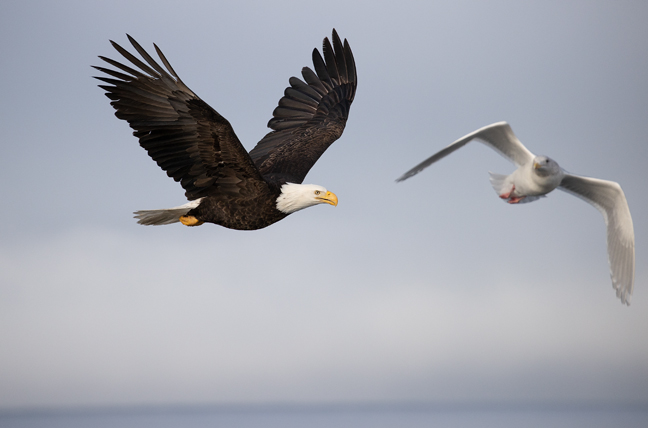

The Odyssey of Homer's Eagles
I recently visited Homer, AK to photograph bald eagles. I had been to Homer in the winter once before to do a story on Jean Keene, the Eagle Lady, who for decades fed bald eagles at the end of the Homer Spit. Hundreds of eagles would gather to feed on fish and carrion that she put out and hundreds of photographers would show up. The City Council banned this practice after her death more than a decade ago and I was interested in seeing how (or if) things had changed.
Homer is a quiet town in the winter months compared to the summer when it overflows with tourists and floatplane passengers. During the winter there are a few commercial fisherman in town preparing for the upcoming season and a few folks fishing for king salmon or crabbing. There are also bald eagle photography tours that regularly depart from the harbor. Since the feeding of bald eagles was banned in Homer, photography guides now use beaches across the Bay and in nearby Peterson and China Poot Bays.
They fill a tub with a box or two of frozen herring, hire a fish thrower and take customers out where they’ll spend a few hours each morning and afternoon photographing bald eagles competing with the glaucous gulls for the small dead fish. It’s easy to make beautiful photographs of eagles in flight, eagles fishing for hand-tossed frozen herring and eagles sitting on drift, posing for portraits. Often, guides don’t advertise that they bait the eagles and photographers only learn of this practice after they arrive. Many don’t care and just welcome the opportunity to make great photographs of bald eagles. Others, like me, do care.
No doubt, it’s a lot more fun and a lot easier to have bald eagles gliding down to the water grabbing frozen bait fish every few minutes than waiting for hours for such a possibility to naturally occur, especially in the winter in Kachemak Bay where there are few fish for eagles to feed on. And, especially when participants have paid for the privilege. I believe that guides offering such workshops have an obligation to be upfront about what they are doing so that photographers can decide beforehand whether or not they wish to participate under such conditions.
The National Audubon Society says, “Though you may be tempted to set out food to draw eagles closer in order to get a great shot, baiting Bald Eagles isn’t just ethically untenable, it’s also arguably illegal, as it could be interpreted as a violation of the Bald and Golden Eagle Protection Act.”
I don’t make a living photographing wildlife and I don’t feel that I should judge other photographers who do. It’s not an easy way to make a living. I like being in wild places and sharing my images with friends who will never come to such places. I could have walked out of the opening meeting, packed my bags and gotten an earlier flight home, but that wouldn’t have accomplished anything. This way, you know how I feel about baiting wildlife for photography, know that all of the fishing shots that I am sharing do not represent natural behaviors and know to question similar photographs that you see.
©Rich Beckman


The Odyssey of Homer's Eagles
I recently visited Homer, AK to photograph bald eagles. I had been to Homer in the winter once before to do a story on Jean Keene, the Eagle Lady, who for decades fed bald eagles at the end of the Homer Spit. Hundreds of eagles would gather to feed on fish and carrion that she put out and hundreds of photographers would show up. The City Council banned this practice after her death more than a decade ago and I was interested in seeing how (or if) things had changed.
Homer is a quiet town in the winter months compared to the summer when it overflows with tourists and floatplane passengers. During the winter there are a few commercial fisherman in town preparing for the upcoming season and a few folks fishing for king salmon or crabbing. There are also bald eagle photography tours that regularly depart from the harbor. Since the feeding of bald eagles was banned in Homer, photography guides now use beaches across the Bay and in nearby Peterson and China Poot Bays.
They fill a tub with a box or two of frozen herring, hire a fish thrower and take customers out where they’ll spend a few hours each morning and afternoon photographing bald eagles competing with the glaucous gulls for the small dead fish. It’s easy to make beautiful photographs of eagles in flight, eagles fishing for hand-tossed frozen herring and eagles sitting on drift, posing for portraits. Often, guides don’t advertise that they bait the eagles and photographers only learn of this practice after they arrive. Many don’t care and just welcome the opportunity to make great photographs of bald eagles. Others, like me, do care.
No doubt, it’s a lot more fun and a lot easier to have bald eagles gliding down to the water grabbing frozen bait fish every few minutes than waiting for hours for such a possibility to naturally occur, especially in the winter in Kachemak Bay where there are few fish for eagles to feed on. And, especially when participants have paid for the privilege. I believe that guides offering such workshops have an obligation to be upfront about what they are doing so that photographers can decide beforehand whether or not they wish to participate under such conditions.
The National Audubon Society says, “Though you may be tempted to set out food to draw eagles closer in order to get a great shot, baiting Bald Eagles isn’t just ethically untenable, it’s also arguably illegal, as it could be interpreted as a violation of the Bald and Golden Eagle Protection Act.”
I don’t make a living photographing wildlife and I don’t feel that I should judge other photographers who do. It’s not an easy way to make a living. I like being in wild places and sharing my images with friends who will never come to such places. I could have walked out of the opening meeting, packed my bags and gotten an earlier flight home, but that wouldn’t have accomplished anything. This way, you know how I feel about baiting wildlife for photography, know that all of the fishing shots that I am sharing do not represent natural behaviors and know to question similar photographs that you see.
©Rich Beckman
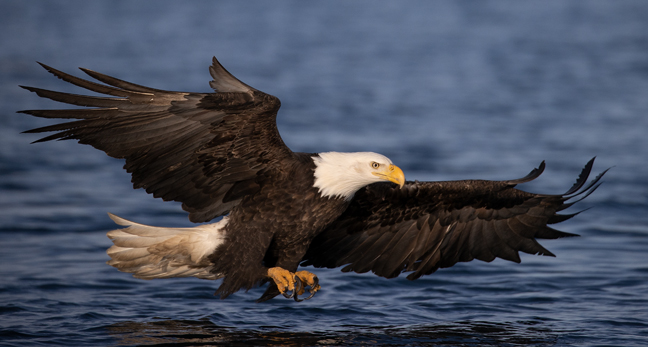

The Odyssey of Homer's Eagles
I recently visited Homer, AK to photograph bald eagles. I had been to Homer in the winter once before to do a story on Jean Keene, the Eagle Lady, who for decades fed bald eagles at the end of the Homer Spit. Hundreds of eagles would gather to feed on fish and carrion that she put out and hundreds of photographers would show up. The City Council banned this practice after her death more than a decade ago and I was interested in seeing how (or if) things had changed.
Homer is a quiet town in the winter months compared to the summer when it overflows with tourists and floatplane passengers. During the winter there are a few commercial fisherman in town preparing for the upcoming season and a few folks fishing for king salmon or crabbing. There are also bald eagle photography tours that regularly depart from the harbor. Since the feeding of bald eagles was banned in Homer, photography guides now use beaches across the Bay and in nearby Peterson and China Poot Bays.
They fill a tub with a box or two of frozen herring, hire a fish thrower and take customers out where they’ll spend a few hours each morning and afternoon photographing bald eagles competing with the glaucous gulls for the small dead fish. It’s easy to make beautiful photographs of eagles in flight, eagles fishing for hand-tossed frozen herring and eagles sitting on drift, posing for portraits. Often, guides don’t advertise that they bait the eagles and photographers only learn of this practice after they arrive. Many don’t care and just welcome the opportunity to make great photographs of bald eagles. Others, like me, do care.
No doubt, it’s a lot more fun and a lot easier to have bald eagles gliding down to the water grabbing frozen bait fish every few minutes than waiting for hours for such a possibility to naturally occur, especially in the winter in Kachemak Bay where there are few fish for eagles to feed on. And, especially when participants have paid for the privilege. I believe that guides offering such workshops have an obligation to be upfront about what they are doing so that photographers can decide beforehand whether or not they wish to participate under such conditions.
The National Audubon Society says, “Though you may be tempted to set out food to draw eagles closer in order to get a great shot, baiting Bald Eagles isn’t just ethically untenable, it’s also arguably illegal, as it could be interpreted as a violation of the Bald and Golden Eagle Protection Act.”
I don’t make a living photographing wildlife and I don’t feel that I should judge other photographers who do. It’s not an easy way to make a living. I like being in wild places and sharing my images with friends who will never come to such places. I could have walked out of the opening meeting, packed my bags and gotten an earlier flight home, but that wouldn’t have accomplished anything. This way, you know how I feel about baiting wildlife for photography, know that all of the fishing shots that I am sharing do not represent natural behaviors and know to question similar photographs that you see.
©Rich Beckman
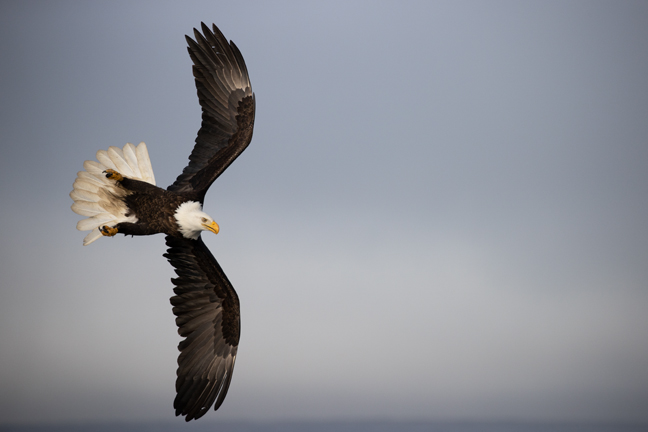

The Odyssey of Homer's Eagles
I recently visited Homer, AK to photograph bald eagles. I had been to Homer in the winter once before to do a story on Jean Keene, the Eagle Lady, who for decades fed bald eagles at the end of the Homer Spit. Hundreds of eagles would gather to feed on fish and carrion that she put out and hundreds of photographers would show up. The City Council banned this practice after her death more than a decade ago and I was interested in seeing how (or if) things had changed.
Homer is a quiet town in the winter months compared to the summer when it overflows with tourists and floatplane passengers. During the winter there are a few commercial fisherman in town preparing for the upcoming season and a few folks fishing for king salmon or crabbing. There are also bald eagle photography tours that regularly depart from the harbor. Since the feeding of bald eagles was banned in Homer, photography guides now use beaches across the Bay and in nearby Peterson and China Poot Bays.
They fill a tub with a box or two of frozen herring, hire a fish thrower and take customers out where they’ll spend a few hours each morning and afternoon photographing bald eagles competing with the glaucous gulls for the small dead fish. It’s easy to make beautiful photographs of eagles in flight, eagles fishing for hand-tossed frozen herring and eagles sitting on drift, posing for portraits. Often, guides don’t advertise that they bait the eagles and photographers only learn of this practice after they arrive. Many don’t care and just welcome the opportunity to make great photographs of bald eagles. Others, like me, do care.
No doubt, it’s a lot more fun and a lot easier to have bald eagles gliding down to the water grabbing frozen bait fish every few minutes than waiting for hours for such a possibility to naturally occur, especially in the winter in Kachemak Bay where there are few fish for eagles to feed on. And, especially when participants have paid for the privilege. I believe that guides offering such workshops have an obligation to be upfront about what they are doing so that photographers can decide beforehand whether or not they wish to participate under such conditions.
The National Audubon Society says, “Though you may be tempted to set out food to draw eagles closer in order to get a great shot, baiting Bald Eagles isn’t just ethically untenable, it’s also arguably illegal, as it could be interpreted as a violation of the Bald and Golden Eagle Protection Act.”
I don’t make a living photographing wildlife and I don’t feel that I should judge other photographers who do. It’s not an easy way to make a living. I like being in wild places and sharing my images with friends who will never come to such places. I could have walked out of the opening meeting, packed my bags and gotten an earlier flight home, but that wouldn’t have accomplished anything. This way, you know how I feel about baiting wildlife for photography, know that all of the fishing shots that I am sharing do not represent natural behaviors and know to question similar photographs that you see.
©Rich Beckman
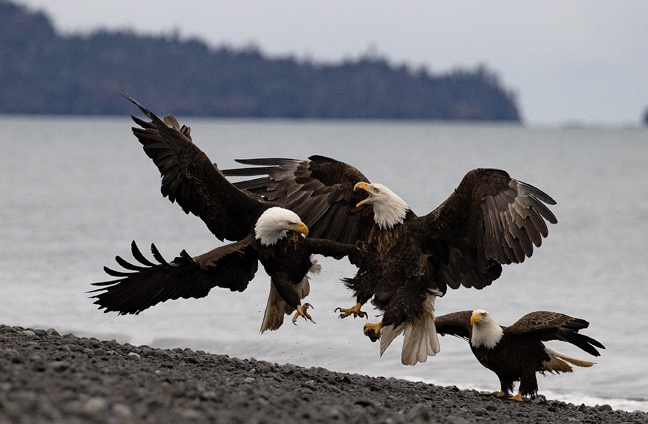

The Odyssey of Homer's Eagles
I recently visited Homer, AK to photograph bald eagles. I had been to Homer in the winter once before to do a story on Jean Keene, the Eagle Lady, who for decades fed bald eagles at the end of the Homer Spit. Hundreds of eagles would gather to feed on fish and carrion that she put out and hundreds of photographers would show up. The City Council banned this practice after her death more than a decade ago and I was interested in seeing how (or if) things had changed.
Homer is a quiet town in the winter months compared to the summer when it overflows with tourists and floatplane passengers. During the winter there are a few commercial fisherman in town preparing for the upcoming season and a few folks fishing for king salmon or crabbing. There are also bald eagle photography tours that regularly depart from the harbor. Since the feeding of bald eagles was banned in Homer, photography guides now use beaches across the Bay and in nearby Peterson and China Poot Bays.
They fill a tub with a box or two of frozen herring, hire a fish thrower and take customers out where they’ll spend a few hours each morning and afternoon photographing bald eagles competing with the glaucous gulls for the small dead fish. It’s easy to make beautiful photographs of eagles in flight, eagles fishing for hand-tossed frozen herring and eagles sitting on drift, posing for portraits. Often, guides don’t advertise that they bait the eagles and photographers only learn of this practice after they arrive. Many don’t care and just welcome the opportunity to make great photographs of bald eagles. Others, like me, do care.
No doubt, it’s a lot more fun and a lot easier to have bald eagles gliding down to the water grabbing frozen bait fish every few minutes than waiting for hours for such a possibility to naturally occur, especially in the winter in Kachemak Bay where there are few fish for eagles to feed on. And, especially when participants have paid for the privilege. I believe that guides offering such workshops have an obligation to be upfront about what they are doing so that photographers can decide beforehand whether or not they wish to participate under such conditions.
The National Audubon Society says, “Though you may be tempted to set out food to draw eagles closer in order to get a great shot, baiting Bald Eagles isn’t just ethically untenable, it’s also arguably illegal, as it could be interpreted as a violation of the Bald and Golden Eagle Protection Act.”
I don’t make a living photographing wildlife and I don’t feel that I should judge other photographers who do. It’s not an easy way to make a living. I like being in wild places and sharing my images with friends who will never come to such places. I could have walked out of the opening meeting, packed my bags and gotten an earlier flight home, but that wouldn’t have accomplished anything. This way, you know how I feel about baiting wildlife for photography, know that all of the fishing shots that I am sharing do not represent natural behaviors and know to question similar photographs that you see.
©Rich Beckman
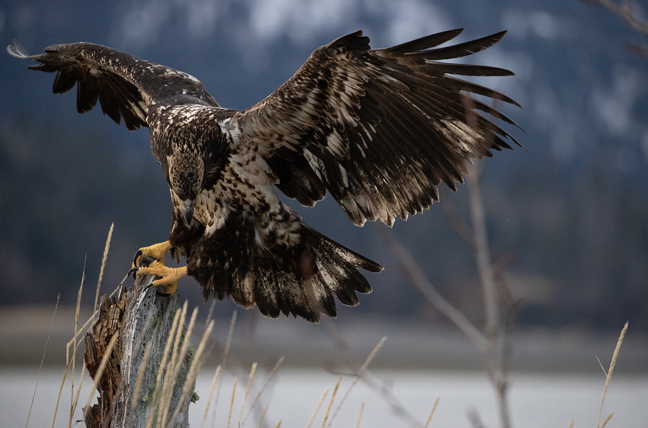

The Odyssey of Homer's Eagles
I recently visited Homer, AK to photograph bald eagles. I had been to Homer in the winter once before to do a story on Jean Keene, the Eagle Lady, who for decades fed bald eagles at the end of the Homer Spit. Hundreds of eagles would gather to feed on fish and carrion that she put out and hundreds of photographers would show up. The City Council banned this practice after her death more than a decade ago and I was interested in seeing how (or if) things had changed.
Homer is a quiet town in the winter months compared to the summer when it overflows with tourists and floatplane passengers. During the winter there are a few commercial fisherman in town preparing for the upcoming season and a few folks fishing for king salmon or crabbing. There are also bald eagle photography tours that regularly depart from the harbor. Since the feeding of bald eagles was banned in Homer, photography guides now use beaches across the Bay and in nearby Peterson and China Poot Bays.
They fill a tub with a box or two of frozen herring, hire a fish thrower and take customers out where they’ll spend a few hours each morning and afternoon photographing bald eagles competing with the glaucous gulls for the small dead fish. It’s easy to make beautiful photographs of eagles in flight, eagles fishing for hand-tossed frozen herring and eagles sitting on drift, posing for portraits. Often, guides don’t advertise that they bait the eagles and photographers only learn of this practice after they arrive. Many don’t care and just welcome the opportunity to make great photographs of bald eagles. Others, like me, do care.
No doubt, it’s a lot more fun and a lot easier to have bald eagles gliding down to the water grabbing frozen bait fish every few minutes than waiting for hours for such a possibility to naturally occur, especially in the winter in Kachemak Bay where there are few fish for eagles to feed on. And, especially when participants have paid for the privilege. I believe that guides offering such workshops have an obligation to be upfront about what they are doing so that photographers can decide beforehand whether or not they wish to participate under such conditions.
The National Audubon Society says, “Though you may be tempted to set out food to draw eagles closer in order to get a great shot, baiting Bald Eagles isn’t just ethically untenable, it’s also arguably illegal, as it could be interpreted as a violation of the Bald and Golden Eagle Protection Act.”
I don’t make a living photographing wildlife and I don’t feel that I should judge other photographers who do. It’s not an easy way to make a living. I like being in wild places and sharing my images with friends who will never come to such places. I could have walked out of the opening meeting, packed my bags and gotten an earlier flight home, but that wouldn’t have accomplished anything. This way, you know how I feel about baiting wildlife for photography, know that all of the fishing shots that I am sharing do not represent natural behaviors and know to question similar photographs that you see.
©Rich Beckman
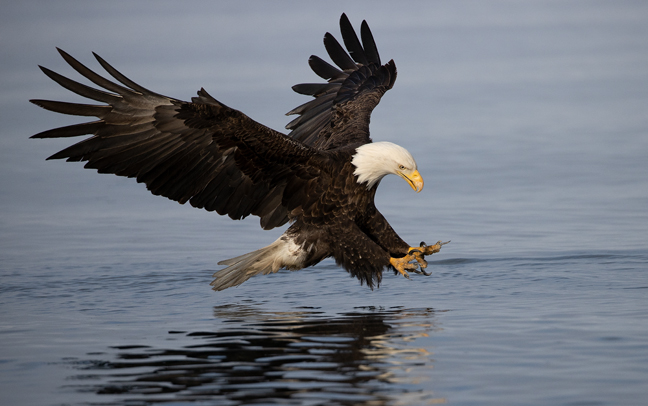

The Odyssey of Homer's Eagles
I recently visited Homer, AK to photograph bald eagles. I had been to Homer in the winter once before to do a story on Jean Keene, the Eagle Lady, who for decades fed bald eagles at the end of the Homer Spit. Hundreds of eagles would gather to feed on fish and carrion that she put out and hundreds of photographers would show up. The City Council banned this practice after her death more than a decade ago and I was interested in seeing how (or if) things had changed.
Homer is a quiet town in the winter months compared to the summer when it overflows with tourists and floatplane passengers. During the winter there are a few commercial fisherman in town preparing for the upcoming season and a few folks fishing for king salmon or crabbing. There are also bald eagle photography tours that regularly depart from the harbor. Since the feeding of bald eagles was banned in Homer, photography guides now use beaches across the Bay and in nearby Peterson and China Poot Bays.
They fill a tub with a box or two of frozen herring, hire a fish thrower and take customers out where they’ll spend a few hours each morning and afternoon photographing bald eagles competing with the glaucous gulls for the small dead fish. It’s easy to make beautiful photographs of eagles in flight, eagles fishing for hand-tossed frozen herring and eagles sitting on drift, posing for portraits. Often, guides don’t advertise that they bait the eagles and photographers only learn of this practice after they arrive. Many don’t care and just welcome the opportunity to make great photographs of bald eagles. Others, like me, do care.
No doubt, it’s a lot more fun and a lot easier to have bald eagles gliding down to the water grabbing frozen bait fish every few minutes than waiting for hours for such a possibility to naturally occur, especially in the winter in Kachemak Bay where there are few fish for eagles to feed on. And, especially when participants have paid for the privilege. I believe that guides offering such workshops have an obligation to be upfront about what they are doing so that photographers can decide beforehand whether or not they wish to participate under such conditions.
The National Audubon Society says, “Though you may be tempted to set out food to draw eagles closer in order to get a great shot, baiting Bald Eagles isn’t just ethically untenable, it’s also arguably illegal, as it could be interpreted as a violation of the Bald and Golden Eagle Protection Act.”
I don’t make a living photographing wildlife and I don’t feel that I should judge other photographers who do. It’s not an easy way to make a living. I like being in wild places and sharing my images with friends who will never come to such places. I could have walked out of the opening meeting, packed my bags and gotten an earlier flight home, but that wouldn’t have accomplished anything. This way, you know how I feel about baiting wildlife for photography, know that all of the fishing shots that I am sharing do not represent natural behaviors and know to question similar photographs that you see.
©Rich Beckman
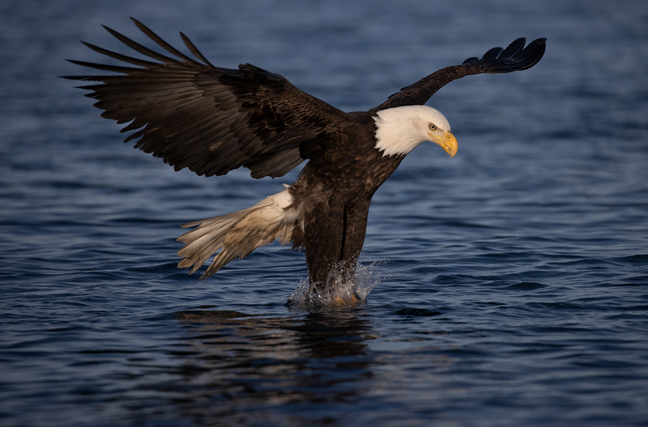

The Odyssey of Homer's Eagles
I recently visited Homer, AK to photograph bald eagles. I had been to Homer in the winter once before to do a story on Jean Keene, the Eagle Lady, who for decades fed bald eagles at the end of the Homer Spit. Hundreds of eagles would gather to feed on fish and carrion that she put out and hundreds of photographers would show up. The City Council banned this practice after her death more than a decade ago and I was interested in seeing how (or if) things had changed.
Homer is a quiet town in the winter months compared to the summer when it overflows with tourists and floatplane passengers. During the winter there are a few commercial fisherman in town preparing for the upcoming season and a few folks fishing for king salmon or crabbing. There are also bald eagle photography tours that regularly depart from the harbor. Since the feeding of bald eagles was banned in Homer, photography guides now use beaches across the Bay and in nearby Peterson and China Poot Bays.
They fill a tub with a box or two of frozen herring, hire a fish thrower and take customers out where they’ll spend a few hours each morning and afternoon photographing bald eagles competing with the glaucous gulls for the small dead fish. It’s easy to make beautiful photographs of eagles in flight, eagles fishing for hand-tossed frozen herring and eagles sitting on drift, posing for portraits. Often, guides don’t advertise that they bait the eagles and photographers only learn of this practice after they arrive. Many don’t care and just welcome the opportunity to make great photographs of bald eagles. Others, like me, do care.
No doubt, it’s a lot more fun and a lot easier to have bald eagles gliding down to the water grabbing frozen bait fish every few minutes than waiting for hours for such a possibility to naturally occur, especially in the winter in Kachemak Bay where there are few fish for eagles to feed on. And, especially when participants have paid for the privilege. I believe that guides offering such workshops have an obligation to be upfront about what they are doing so that photographers can decide beforehand whether or not they wish to participate under such conditions.
The National Audubon Society says, “Though you may be tempted to set out food to draw eagles closer in order to get a great shot, baiting Bald Eagles isn’t just ethically untenable, it’s also arguably illegal, as it could be interpreted as a violation of the Bald and Golden Eagle Protection Act.”
I don’t make a living photographing wildlife and I don’t feel that I should judge other photographers who do. It’s not an easy way to make a living. I like being in wild places and sharing my images with friends who will never come to such places. I could have walked out of the opening meeting, packed my bags and gotten an earlier flight home, but that wouldn’t have accomplished anything. This way, you know how I feel about baiting wildlife for photography, know that all of the fishing shots that I am sharing do not represent natural behaviors and know to question similar photographs that you see.
©Rich Beckman
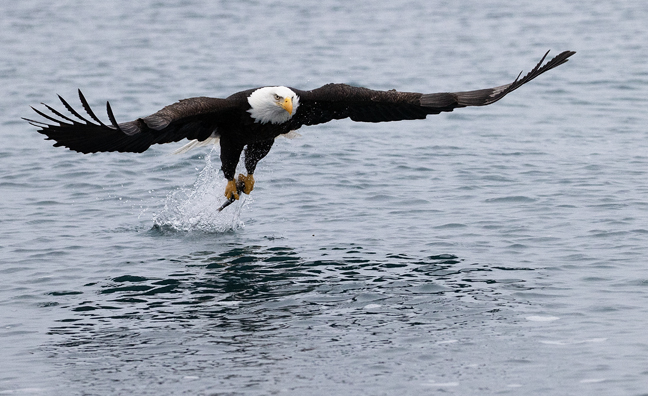

The Odyssey of Homer's Eagles
I recently visited Homer, AK to photograph bald eagles. I had been to Homer in the winter once before to do a story on Jean Keene, the Eagle Lady, who for decades fed bald eagles at the end of the Homer Spit. Hundreds of eagles would gather to feed on fish and carrion that she put out and hundreds of photographers would show up. The City Council banned this practice after her death more than a decade ago and I was interested in seeing how (or if) things had changed.
Homer is a quiet town in the winter months compared to the summer when it overflows with tourists and floatplane passengers. During the winter there are a few commercial fisherman in town preparing for the upcoming season and a few folks fishing for king salmon or crabbing. There are also bald eagle photography tours that regularly depart from the harbor. Since the feeding of bald eagles was banned in Homer, photography guides now use beaches across the Bay and in nearby Peterson and China Poot Bays.
They fill a tub with a box or two of frozen herring, hire a fish thrower and take customers out where they’ll spend a few hours each morning and afternoon photographing bald eagles competing with the glaucous gulls for the small dead fish. It’s easy to make beautiful photographs of eagles in flight, eagles fishing for hand-tossed frozen herring and eagles sitting on drift, posing for portraits. Often, guides don’t advertise that they bait the eagles and photographers only learn of this practice after they arrive. Many don’t care and just welcome the opportunity to make great photographs of bald eagles. Others, like me, do care.
No doubt, it’s a lot more fun and a lot easier to have bald eagles gliding down to the water grabbing frozen bait fish every few minutes than waiting for hours for such a possibility to naturally occur, especially in the winter in Kachemak Bay where there are few fish for eagles to feed on. And, especially when participants have paid for the privilege. I believe that guides offering such workshops have an obligation to be upfront about what they are doing so that photographers can decide beforehand whether or not they wish to participate under such conditions.
The National Audubon Society says, “Though you may be tempted to set out food to draw eagles closer in order to get a great shot, baiting Bald Eagles isn’t just ethically untenable, it’s also arguably illegal, as it could be interpreted as a violation of the Bald and Golden Eagle Protection Act.”
I don’t make a living photographing wildlife and I don’t feel that I should judge other photographers who do. It’s not an easy way to make a living. I like being in wild places and sharing my images with friends who will never come to such places. I could have walked out of the opening meeting, packed my bags and gotten an earlier flight home, but that wouldn’t have accomplished anything. This way, you know how I feel about baiting wildlife for photography, know that all of the fishing shots that I am sharing do not represent natural behaviors and know to question similar photographs that you see.
©Rich Beckman
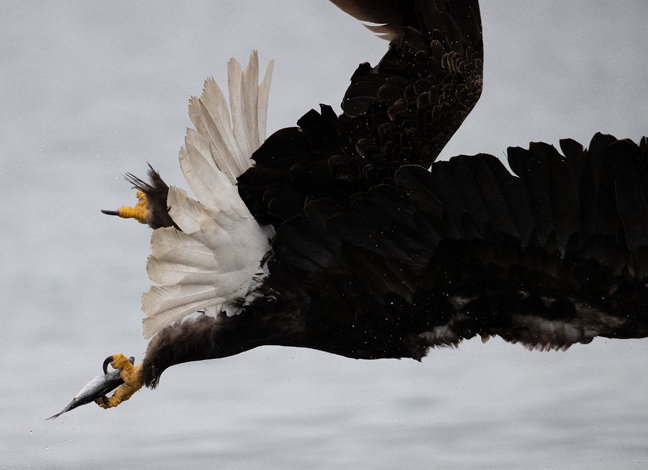

The Odyssey of Homer's Eagles
I recently visited Homer, AK to photograph bald eagles. I had been to Homer in the winter once before to do a story on Jean Keene, the Eagle Lady, who for decades fed bald eagles at the end of the Homer Spit. Hundreds of eagles would gather to feed on fish and carrion that she put out and hundreds of photographers would show up. The City Council banned this practice after her death more than a decade ago and I was interested in seeing how (or if) things had changed.
Homer is a quiet town in the winter months compared to the summer when it overflows with tourists and floatplane passengers. During the winter there are a few commercial fisherman in town preparing for the upcoming season and a few folks fishing for king salmon or crabbing. There are also bald eagle photography tours that regularly depart from the harbor. Since the feeding of bald eagles was banned in Homer, photography guides now use beaches across the Bay and in nearby Peterson and China Poot Bays.
They fill a tub with a box or two of frozen herring, hire a fish thrower and take customers out where they’ll spend a few hours each morning and afternoon photographing bald eagles competing with the glaucous gulls for the small dead fish. It’s easy to make beautiful photographs of eagles in flight, eagles fishing for hand-tossed frozen herring and eagles sitting on drift, posing for portraits. Often, guides don’t advertise that they bait the eagles and photographers only learn of this practice after they arrive. Many don’t care and just welcome the opportunity to make great photographs of bald eagles. Others, like me, do care.
No doubt, it’s a lot more fun and a lot easier to have bald eagles gliding down to the water grabbing frozen bait fish every few minutes than waiting for hours for such a possibility to naturally occur, especially in the winter in Kachemak Bay where there are few fish for eagles to feed on. And, especially when participants have paid for the privilege. I believe that guides offering such workshops have an obligation to be upfront about what they are doing so that photographers can decide beforehand whether or not they wish to participate under such conditions.
The National Audubon Society says, “Though you may be tempted to set out food to draw eagles closer in order to get a great shot, baiting Bald Eagles isn’t just ethically untenable, it’s also arguably illegal, as it could be interpreted as a violation of the Bald and Golden Eagle Protection Act.”
I don’t make a living photographing wildlife and I don’t feel that I should judge other photographers who do. It’s not an easy way to make a living. I like being in wild places and sharing my images with friends who will never come to such places. I could have walked out of the opening meeting, packed my bags and gotten an earlier flight home, but that wouldn’t have accomplished anything. This way, you know how I feel about baiting wildlife for photography, know that all of the fishing shots that I am sharing do not represent natural behaviors and know to question similar photographs that you see.
©Rich Beckman
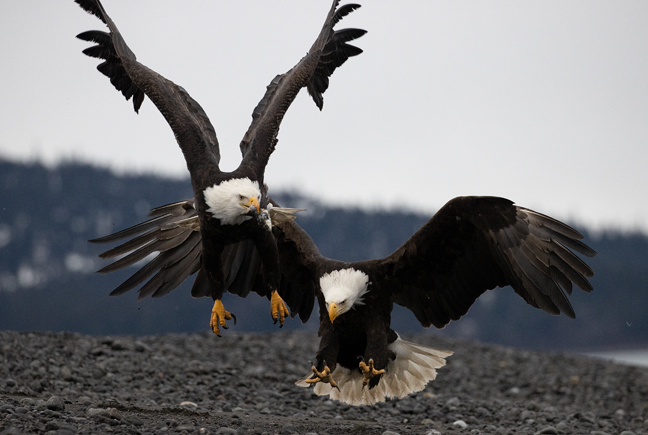

The Odyssey of Homer's Eagles
I recently visited Homer, AK to photograph bald eagles. I had been to Homer in the winter once before to do a story on Jean Keene, the Eagle Lady, who for decades fed bald eagles at the end of the Homer Spit. Hundreds of eagles would gather to feed on fish and carrion that she put out and hundreds of photographers would show up. The City Council banned this practice after her death more than a decade ago and I was interested in seeing how (or if) things had changed.
Homer is a quiet town in the winter months compared to the summer when it overflows with tourists and floatplane passengers. During the winter there are a few commercial fisherman in town preparing for the upcoming season and a few folks fishing for king salmon or crabbing. There are also bald eagle photography tours that regularly depart from the harbor. Since the feeding of bald eagles was banned in Homer, photography guides now use beaches across the Bay and in nearby Peterson and China Poot Bays.
They fill a tub with a box or two of frozen herring, hire a fish thrower and take customers out where they’ll spend a few hours each morning and afternoon photographing bald eagles competing with the glaucous gulls for the small dead fish. It’s easy to make beautiful photographs of eagles in flight, eagles fishing for hand-tossed frozen herring and eagles sitting on drift, posing for portraits. Often, guides don’t advertise that they bait the eagles and photographers only learn of this practice after they arrive. Many don’t care and just welcome the opportunity to make great photographs of bald eagles. Others, like me, do care.
No doubt, it’s a lot more fun and a lot easier to have bald eagles gliding down to the water grabbing frozen bait fish every few minutes than waiting for hours for such a possibility to naturally occur, especially in the winter in Kachemak Bay where there are few fish for eagles to feed on. And, especially when participants have paid for the privilege. I believe that guides offering such workshops have an obligation to be upfront about what they are doing so that photographers can decide beforehand whether or not they wish to participate under such conditions.
The National Audubon Society says, “Though you may be tempted to set out food to draw eagles closer in order to get a great shot, baiting Bald Eagles isn’t just ethically untenable, it’s also arguably illegal, as it could be interpreted as a violation of the Bald and Golden Eagle Protection Act.”
I don’t make a living photographing wildlife and I don’t feel that I should judge other photographers who do. It’s not an easy way to make a living. I like being in wild places and sharing my images with friends who will never come to such places. I could have walked out of the opening meeting, packed my bags and gotten an earlier flight home, but that wouldn’t have accomplished anything. This way, you know how I feel about baiting wildlife for photography, know that all of the fishing shots that I am sharing do not represent natural behaviors and know to question similar photographs that you see.
©Rich Beckman
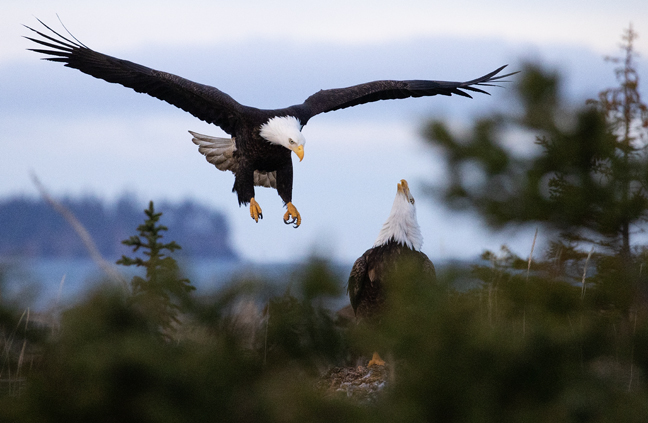

The Odyssey of Homer's Eagles
I recently visited Homer, AK to photograph bald eagles. I had been to Homer in the winter once before to do a story on Jean Keene, the Eagle Lady, who for decades fed bald eagles at the end of the Homer Spit. Hundreds of eagles would gather to feed on fish and carrion that she put out and hundreds of photographers would show up. The City Council banned this practice after her death more than a decade ago and I was interested in seeing how (or if) things had changed.
Homer is a quiet town in the winter months compared to the summer when it overflows with tourists and floatplane passengers. During the winter there are a few commercial fisherman in town preparing for the upcoming season and a few folks fishing for king salmon or crabbing. There are also bald eagle photography tours that regularly depart from the harbor. Since the feeding of bald eagles was banned in Homer, photography guides now use beaches across the Bay and in nearby Peterson and China Poot Bays.
They fill a tub with a box or two of frozen herring, hire a fish thrower and take customers out where they’ll spend a few hours each morning and afternoon photographing bald eagles competing with the glaucous gulls for the small dead fish. It’s easy to make beautiful photographs of eagles in flight, eagles fishing for hand-tossed frozen herring and eagles sitting on drift, posing for portraits. Often, guides don’t advertise that they bait the eagles and photographers only learn of this practice after they arrive. Many don’t care and just welcome the opportunity to make great photographs of bald eagles. Others, like me, do care.
No doubt, it’s a lot more fun and a lot easier to have bald eagles gliding down to the water grabbing frozen bait fish every few minutes than waiting for hours for such a possibility to naturally occur, especially in the winter in Kachemak Bay where there are few fish for eagles to feed on. And, especially when participants have paid for the privilege. I believe that guides offering such workshops have an obligation to be upfront about what they are doing so that photographers can decide beforehand whether or not they wish to participate under such conditions.
The National Audubon Society says, “Though you may be tempted to set out food to draw eagles closer in order to get a great shot, baiting Bald Eagles isn’t just ethically untenable, it’s also arguably illegal, as it could be interpreted as a violation of the Bald and Golden Eagle Protection Act.”
I don’t make a living photographing wildlife and I don’t feel that I should judge other photographers who do. It’s not an easy way to make a living. I like being in wild places and sharing my images with friends who will never come to such places. I could have walked out of the opening meeting, packed my bags and gotten an earlier flight home, but that wouldn’t have accomplished anything. This way, you know how I feel about baiting wildlife for photography, know that all of the fishing shots that I am sharing do not represent natural behaviors and know to question similar photographs that you see.
©Rich Beckman


The Odyssey of Homer's Eagles
I recently visited Homer, AK to photograph bald eagles. I had been to Homer in the winter once before to do a story on Jean Keene, the Eagle Lady, who for decades fed bald eagles at the end of the Homer Spit. Hundreds of eagles would gather to feed on fish and carrion that she put out and hundreds of photographers would show up. The City Council banned this practice after her death more than a decade ago and I was interested in seeing how (or if) things had changed.
Homer is a quiet town in the winter months compared to the summer when it overflows with tourists and floatplane passengers. During the winter there are a few commercial fisherman in town preparing for the upcoming season and a few folks fishing for king salmon or crabbing. There are also bald eagle photography tours that regularly depart from the harbor. Since the feeding of bald eagles was banned in Homer, photography guides now use beaches across the Bay and in nearby Peterson and China Poot Bays.
They fill a tub with a box or two of frozen herring, hire a fish thrower and take customers out where they’ll spend a few hours each morning and afternoon photographing bald eagles competing with the glaucous gulls for the small dead fish. It’s easy to make beautiful photographs of eagles in flight, eagles fishing for hand-tossed frozen herring and eagles sitting on drift, posing for portraits. Often, guides don’t advertise that they bait the eagles and photographers only learn of this practice after they arrive. Many don’t care and just welcome the opportunity to make great photographs of bald eagles. Others, like me, do care.
No doubt, it’s a lot more fun and a lot easier to have bald eagles gliding down to the water grabbing frozen bait fish every few minutes than waiting for hours for such a possibility to naturally occur, especially in the winter in Kachemak Bay where there are few fish for eagles to feed on. And, especially when participants have paid for the privilege. I believe that guides offering such workshops have an obligation to be upfront about what they are doing so that photographers can decide beforehand whether or not they wish to participate under such conditions.
The National Audubon Society says, “Though you may be tempted to set out food to draw eagles closer in order to get a great shot, baiting Bald Eagles isn’t just ethically untenable, it’s also arguably illegal, as it could be interpreted as a violation of the Bald and Golden Eagle Protection Act.”
I don’t make a living photographing wildlife and I don’t feel that I should judge other photographers who do. It’s not an easy way to make a living. I like being in wild places and sharing my images with friends who will never come to such places. I could have walked out of the opening meeting, packed my bags and gotten an earlier flight home, but that wouldn’t have accomplished anything. This way, you know how I feel about baiting wildlife for photography, know that all of the fishing shots that I am sharing do not represent natural behaviors and know to question similar photographs that you see.
©Rich Beckman
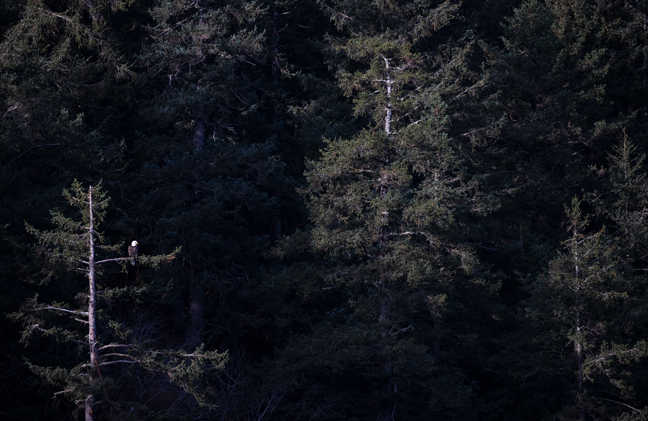

The Odyssey of Homer's Eagles
I recently visited Homer, AK to photograph bald eagles. I had been to Homer in the winter once before to do a story on Jean Keene, the Eagle Lady, who for decades fed bald eagles at the end of the Homer Spit. Hundreds of eagles would gather to feed on fish and carrion that she put out and hundreds of photographers would show up. The City Council banned this practice after her death more than a decade ago and I was interested in seeing how (or if) things had changed.
Homer is a quiet town in the winter months compared to the summer when it overflows with tourists and floatplane passengers. During the winter there are a few commercial fisherman in town preparing for the upcoming season and a few folks fishing for king salmon or crabbing. There are also bald eagle photography tours that regularly depart from the harbor. Since the feeding of bald eagles was banned in Homer, photography guides now use beaches across the Bay and in nearby Peterson and China Poot Bays.
They fill a tub with a box or two of frozen herring, hire a fish thrower and take customers out where they’ll spend a few hours each morning and afternoon photographing bald eagles competing with the glaucous gulls for the small dead fish. It’s easy to make beautiful photographs of eagles in flight, eagles fishing for hand-tossed frozen herring and eagles sitting on drift, posing for portraits. Often, guides don’t advertise that they bait the eagles and photographers only learn of this practice after they arrive. Many don’t care and just welcome the opportunity to make great photographs of bald eagles. Others, like me, do care.
No doubt, it’s a lot more fun and a lot easier to have bald eagles gliding down to the water grabbing frozen bait fish every few minutes than waiting for hours for such a possibility to naturally occur, especially in the winter in Kachemak Bay where there are few fish for eagles to feed on. And, especially when participants have paid for the privilege. I believe that guides offering such workshops have an obligation to be upfront about what they are doing so that photographers can decide beforehand whether or not they wish to participate under such conditions.
The National Audubon Society says, “Though you may be tempted to set out food to draw eagles closer in order to get a great shot, baiting Bald Eagles isn’t just ethically untenable, it’s also arguably illegal, as it could be interpreted as a violation of the Bald and Golden Eagle Protection Act.”
I don’t make a living photographing wildlife and I don’t feel that I should judge other photographers who do. It’s not an easy way to make a living. I like being in wild places and sharing my images with friends who will never come to such places. I could have walked out of the opening meeting, packed my bags and gotten an earlier flight home, but that wouldn’t have accomplished anything. This way, you know how I feel about baiting wildlife for photography, know that all of the fishing shots that I am sharing do not represent natural behaviors and know to question similar photographs that you see.
©Rich Beckman